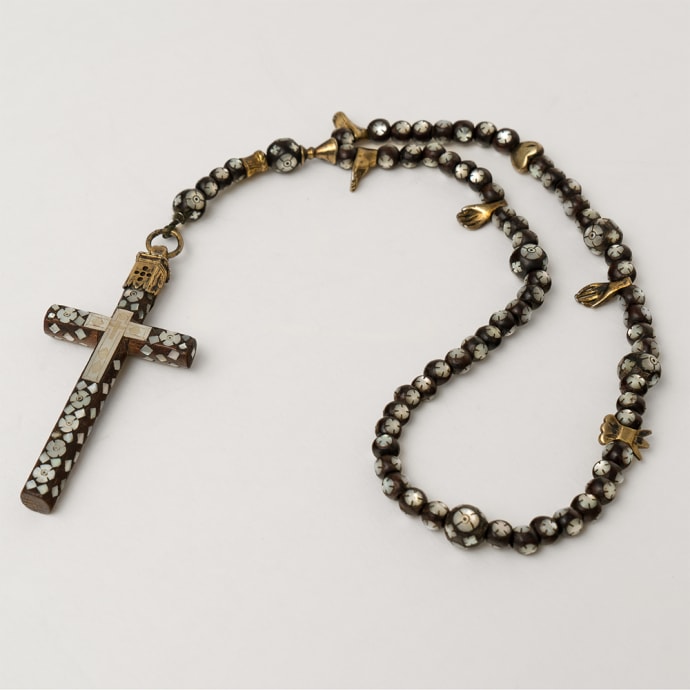


Rosary with Jerusalem Cross
, Southern Germany, late 17th – 18th century


Rosary with Jerusalem Cross
Description
Elegant pilgrim’s rosary and cross from the holy land, skillfully assembled in Germany during the Baroque era
Rosary consisting of fifty-one smaller “Ave Maria” (Hail Mary) and six larger round “Paternoster” (Our Father) wooden beads with cruciform rosettes in mother-of-pearl inlay. Inserted between these are small sculptural silver-gilt symbols of the five wounds of Christ: head with crown of thorns, two feet, two hands, three nails of the cross, heart and chalice. Suspended from the rosary are three beads flanked by larger ones symbolizing the virtues of God: Faith, Hope, Love, and below a cross (Credo cross) with hexagonal cross-section, cruciform-rosette and lozenge-shaped inlay, on the front inserted in the center is a mother-of-pearl plaque with the engraved Christ Crucified and on the reverse a cross surrounded by lozenge shapes. The cross has an ornate silver-gilt mount with pendant loop. The rosary is in good condition. The rosary may have been restrung as is evidenced by the inconsistent number of “Avec Maria” beads between the “Paternoster” beads.
Literature:
In the Middle Ages rosaries became aids for prayer and signs of devotion, and whilst often not seen as jewelry per se, they were made by specialist bead makers and goldsmiths. They can be found depicted in paintings, and from the Middle Ages onwards in Europe, portraits include images of rosaries being handheld, or suspended from a girdle. They were exclusively used for prayer in Catholic dominated countries, for example France, Spain, Italy and in the Alpine regions Austria, parts of Switzerland and Southern Germany. Through the centuries rosaries were customarily presented at Baptisms, First Communion, weddings, donated as votive offerings to places of pilgrimage dedicated to the Virgin Mary, and even acquired as souvenirs. The place of production could in fact often differ from the place of veneration. Similarly, here the beads were most likely to have been brought back from a pilgrimage to the Holy Land, as was the cross, known as a “Jerusalem cross.” As early as the sixteenth century there are records of pilgrims acquiring souvenirs crafted in the town of Bethlehem, known for their wood carving in olive wood and mother-of-pearl, see: Wallfahrt kennt keine Grenzen, Bayerisches Nationalmuseum, Munich, 1984, pp. 56-88 and p. 75 about Bethlehem.
Whilst the beads were brought back from the pilgrimage, the rosary is most likely to have been made in Southern Germany during the seventeenth and eighteenth century, confirmed by both the style of the mount and the silver-gilt inserts, symbolizing Christ’s wounds. Similar examples are known in museums and private collections, see: exh. cat. Edelsteine, Himmelsschnüre, Rosenkränze & Gebetsketten, Dommusuem zu Salzburg, 2008, cat. nos. 2.92; 2.132; 2.134; 2.372-5); Urs Beat Frei/ Fredy Bühler, Der Rosenkranz Andacht Geschichte Kunst, Bern 2003, pp. 390, 476, cat. no. 12 and pp. 427, 480, cat. no. 58; exh. cat. 500 Jahre Rosenkranz 1475 Köln 1975, fig. 31, no. B137. For the spirituality behind rosaries, cf. Eithne Wilkins, The Rose-Garden Game, London 1969 and Anne Winston Allen, Stories of the Rose, Pennsylvannia 1997.
The string of prayer beads remained a portable device for the worshipper to repeat and accurately count prayers with the “Our Father” and “Hail Mary” beads. The term “rosary” stems from the rose, a symbol of the Virgin Mary, described as a “rose without thorns.”
J-35109